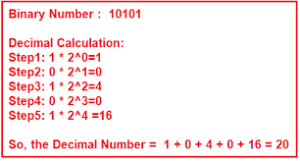Converting a binary number to a decimal number is a fundamental skill in computer science and mathematics. Binary numbers consist of only two digits, 0 and 1, while decimal numbers use a base-10 system with digits from 0 to 9. Let’s use and learn Binary to Decimal Converter.
Table of Contents
Binary to Decimal Conversion
Understanding the Binary Number System
Before we dive into the conversion process, it’s crucial to have a basic understanding of the binary number system. In binary, each digit represents a power of 2, starting from the rightmost digit. For example, the binary number 1011 can be interpreted as (1 * 2^3) + (0 * 2^2) + (1 * 2^1) + (1 * 2^0).
Step-by-Step Detail of Binary to Decimal Converter
To convert a binary number to a decimal number, follow these steps:
- Start from the rightmost digit of the binary number.
- Assign the rightmost digit a value of 2^0, which is 1.
- Move to the next digit on the left and assign it a value of 2^1, which is 2.
- Continue this process, increasing the power of 2 by 1 for each subsequent digit.
- Multiply each digit by the corresponding power of 2.
- Sum up all the values obtained in the previous step to get the decimal equivalent.
Example of Binary to Decimal Converter
Let’s take the binary number 1101 as an example and convert it to decimal using the steps outlined above.
Starting from the rightmost digit: 1 * 2^0 = 1. b. Moving to the next digit: 0 * 2^1 = 0. c. Next digit: 1 * 2^2 = 4. d. Leftmost digit: 1 * 2^3 = 8. e. Summing up the values: 1 + 0 + 4 + 8 = 13.
Therefore, the binary number 1101 is equivalent to the decimal number 13.

Tips and Tricks
-
- When converting a binary number with a large number of digits, it can be helpful to use a table to keep track of the powers of 2 and their corresponding values.
- Make sure to multiply each digit by its respective power of 2 before summing up the values.
- Double-check your calculations to avoid errors, especially with longer binary numbers.
Conclusion
Converting binary numbers to decimal numbers is a fundamental process that allows us to understand and manipulate binary data in various contexts. By following the step-by-step guide outlined in this article, you can confidently convert binary numbers to their decimal equivalents. Mastering this skill will undoubtedly enhance your understanding of computer science, digital systems, and mathematical concepts.
Important Links